Quantum Beam Sci., Volume 6, Issue 4 (December 2022) – 6 articles
The need for thin foil welding is increasing significantly, particularly in the electronic industries. The technologies that are currently available limit the joining processes in terms of materials and their geometries. In this paper, a series of trials of fusion welding (bead-on-plate) of commercially pure titanium (CPTi) foils were conducted using a blue diode laser (BDL) welding method.
The tensile tests revealed that the strengths of the welded samples were slightly lower than those of the unwelded samples. All the samples, welded and unwelded, showed identical fracture mechanisms, i.e., microvoid coalescence or ductile fracture. The weld zone experienced very small strains (elongation) at fracture, which indicates a good weld quality. View this paper
- Issues are regarded as officially published after their release is announced to the table of contents alert mailing list.
- You may sign up for e-mail alerts to receive table of contents of newly released issues.
- PDF is the official format for papers published in both, html and pdf forms. To view the papers in pdf format, click on the "PDF Full-text" link, and use the free Adobe Reader to open them.





